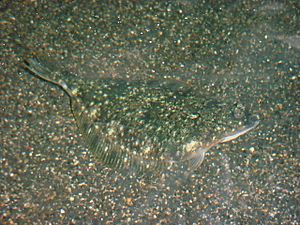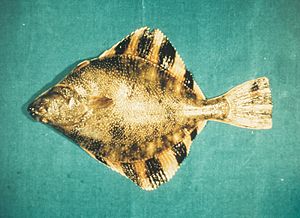Starry flounder facts for kids
The starry flounder (Platichthys stellatus) is a cool type of flatfish found all around the edges of the North Pacific. It's also sometimes called the grindstone or emery wheel because of its rough skin.
This fish has some really unique features! Its fins on the top (called the dorsal fin) and bottom (called the anal fin) have a mix of black and white or orange stripes. Its skin feels rough because it's covered in tiny, star-shaped bumps or scales. This is how it got its name, "starry flounder"! The side of the fish with its eyes is usually black or dark brown. The bottom side, which faces the seabed, is white or cream. Even though these fish are usually "righteye flounders," meaning their eyes are on the right side, some can have their eyes on the left! Starry flounders can grow quite large, up to 91 centimeters (about 3 feet) long and weigh up to 9 kilograms (about 20 pounds).
Starry flounders live close to shore. They can even swim far up into estuaries and into freshwater rivers! Young flounders have been found as far as 120 kilometers (about 75 miles) inland. In the ocean, they can live in waters as deep as 375 meters (about 1,230 feet). They glide along the bottom by wiggling their top and bottom fins. They mostly eat small creatures that live on the seabed. When they are very young, they eat tiny plankton like algae and small crustaceans. As they get older, they start eating bigger prey.
Quick facts for kids Starry flounder |
|
|---|---|
 |
|
 |
|
| Conservation status | |
| Scientific classification | |
| Synonyms | |
|
Contents
Amazing Transformation: How Starry Flounders Grow
When starry flounders are very young, they swim upright in the water, just like most other fish. But as they grow, something amazing happens! They start to tilt to one side while swimming. Eventually, they begin to live lying flat on the sandy or muddy ocean floor.
One of the most important changes is that one of their eyes actually moves! It slowly shifts from one side of their head to the other. This way, both eyes end up on the same side of their body, which is the side that faces up when they lie flat. Another change is that their underside loses its dark color and becomes white or cream. This helps them blend in with the light-colored seabed.
What Starry Flounders Look Like
The starry flounder has a body shaped like an oval, with a thin, pointed head. The side of its body that has its eyes is usually olive green to dark brown, or sometimes even almost black. The side that lies on the bottom (the "blind side") is white or creamy white.
Its fins that are not paired, like the dorsal and anal fins, are white to yellow-orange with black stripes. These stripes run across the fish. The tail fin, which is at the very back, is slightly rounded. This fish also has a special line along its side, called a lateral line, which helps it sense things in the water. This line has a slight curve over its side fin, called the pectoral fin.
Starry flounders use their strong anal spine, which is a bone near their anal fin, to help them swim. They move it up and down to push themselves through the water.
How Starry Flounders Behave
Resting and Moving
When a starry flounder is resting on the seabed, its dorsal and anal fins are angled. This helps lift its body slightly off the bottom. It creates a small cushion of water between the fish and the sand. This also allows water to flow out through a gill slit on its blind side. This clever trick means the fish doesn't have to work as hard to move when it wants to.
When a starry flounder moves slowly, it looks a bit like it's crawling. The first few rays (or bones) of its dorsal and anal fins move in a rowing motion. This movement then ripples down the rest of the fins, creating a wave-like motion that pushes the fish forward.
Starry flounders can also swim backward! They use the same waving motion of their fins, but the movement goes from the back of the fish to the front. They use this backward movement to escape quickly or if they bump into something. When they need to move very fast, like when they are hunting food or are scared, they stick out their pectoral fin at a right angle. This fin acts like an extra paddle to help them speed up.
Amazing Camouflage
One of the coolest things about the starry flounder is its ability to change its body color! It can match the color of the sand, mud, or gravel it's resting on. This helps it hide from predators and sneak up on prey. It does this by changing how much pigment (color) is in special cells called chromatophores in its skin. This allows it to create different shades and blend in perfectly with its surroundings.
Where Starry Flounders Live and What They Eat
Habitat
Starry flounders mostly live on mud, sand, or gravel bottoms. You can find them from the very shallow waters near the shore down to about 375 meters (1,230 feet) deep. However, they are most often found in waters shallower than 146 meters (479 feet). As mentioned before, they often swim into slightly salty water (brackish water) and even into freshwater. They don't like water that is too salty, though, because it's hard for their bodies to handle it.
Diet
When starry flounders are young, before they change their shape, they eat tiny floating organisms called plankton. As they get older, they hunt for food by waiting for prey to settle on the bottom or swim near their eye level. Then, they make a quick lunge, sucking in a mouthful of water to pull the prey in.
As they grow, they start to eat small clams, some larger fish, other small invertebrates (animals without backbones), and worms. When they become adult starry flounders, their main food source is clams. If a clam is too big to eat whole, they will often just eat its siphons, which are the tubes the clam uses to breathe and feed.
Distribution
The starry flounder has a very wide home range! They live all across the North Pacific Ocean. You can find them from Japan and Korea in the west, all the way through the Bering Strait and Arctic Alaska. They also live along the coasts of Canada and down the West Coast of the U.S., as far south as Santa Barbara.
Starry Flounders and Humans
Fishing
In California, starry flounders are not a huge part of commercial fishing, but they are caught in some fishing ports north of Point Conception. They are usually filleted (meaning their bones are removed) and often sold as "sole" fish. People don't usually think they have the best flavor or texture compared to other fish. Younger and smaller starry flounders are often preferred over the larger, heavier ones. In the Bering Sea, they are caught and often canned to be sold as a high-quality export.


